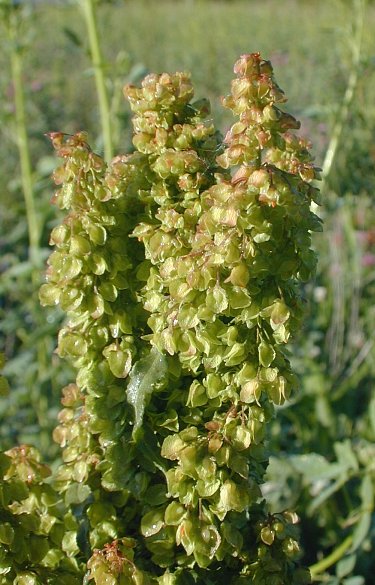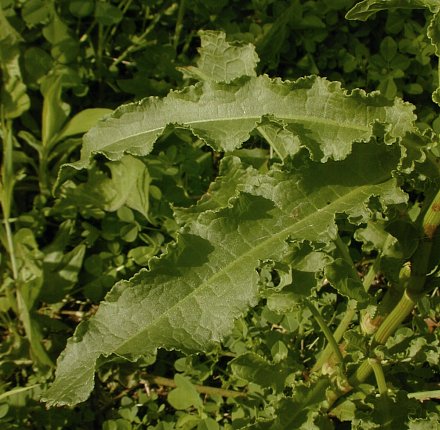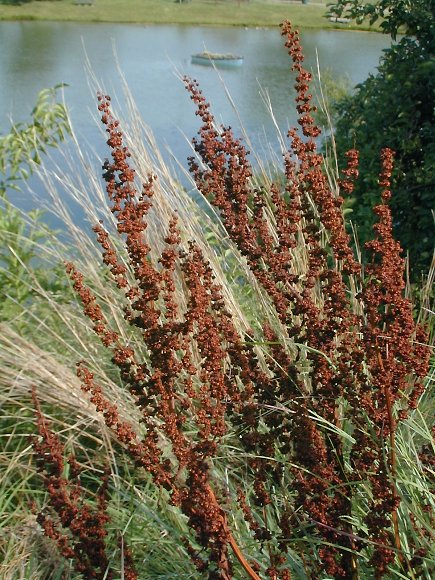Description: This herbaceous perennial plant is 1–3' tall and little branched, except where the flowers occur. Initially, it consists of a rosette of basal leaves about 1' across. A flowering stalk bolts from this rosette during the late spring. This stalk is round in circumference, hairless, and ribbed. The alternate cauline leaves are up to 6" long and 1" across (excluding their petioles). They are oblong-lanceolate, hairless, and dull green. Their margins are crisped and undulate up and down. Their petioles are up to 2" long, becoming broader at the base. The basal leaves have a similar appearance, except that they are somewhat larger in size, their petioles are longer, and their margins are less crisped or wavy. The inflorescence consists of a panicle of racemes with whorls of flowers; it is about ½–1½' long. Each plant has perfect (bisexual) and pistillate (female) flowers; they are pollinated by the wind.

Each yellowish or reddish green flower is about 1/8" (3 mm.) long and consists of 3 inner sepals, 3 outer sepals, 3 styles, and an ovary. Perfect flowers also have 6 stamens. There are no petals. Each flower has a drooping pedicel about ¼" in length. The blooming period occurs during the summer and lasts about a month. There is no floral scent. Each flower matures into a dry fruit about 1/6" (4 mm.) long that contains a single seed. The inner sepals become larger in size and membranous (at this stage, they are often called 'valves'). Each membranous sepal is cordate-oval in shape and only slightly indented or well-rounded at the base. There is an elongated tubercle that is about one-third to one-half the length of the sepal. The margin of each sepal can be smooth or irregularly undulate, but it lacks conspicuous teeth of any kind. The fruit and stems of Curly Dock become dark brown with maturity. The rather large seeds are dark brown and 3-angled, tapering at their tips. They are distributed to some extent by wind or water while adhering to the membranous wings of the fruit. The root system consists of a stout taproot that has a pale yellow interior. This plant spread by reseeding itself.

Cultivation:
Curly
Dock occurs at sites with full sun, moist to dry conditions, and soil
containing loam, clay-loam, or gravelly material. It withstands
drought, temporary flooding, and occasional mowing. The seeds can
persist in the ground for several decades (at least 50 years) and
remain viable.
Range & Habitat:
The non-native Curly Dock is a common plant that probably occurs in
every county of
Illinois (see Distribution
Map).
It is native to Eurasia and it was first observed in
the
United States during the 18th century. Habitats include seeps, glades,
weedy meadows (including areas prone to occasional flooding), pastures
and fallow fields, vacant lots, roadside banks, gravelly areas
along railroads, edges of yards, gardens, and miscellaneous waste
areas.
Disturbed areas are preferred.

Faunal
Associations: The
flowers are cross-pollinated by wind, therefore they attract very few
insect pollinators. The
foliage, roots, seeds, and other parts of Curly Dock (Rumex crispus)
and other dock species (Rumex spp.) are eaten by various insects. This
includes Gastrophysa cyanea (Green Dock Beetle), larvae of Lixus concavus (Rhubarb Weevil), Pegomya bicolor (Curled Dock Leaf-miner), Aphis rumicis (Dock Aphid), larvae of Ametastegia glabrata (Dock Sawfly), larvae of Dypterygia rozmani (American Bird's Wing Moth), and larvae of Lycaena phlaeas americana (American
Copper). Curly Dock and Sheep Sorrel (Rumex acetosella) are the two
known host plants of the butterfly, American Copper. The Insect Table
has a more complete list of insects that feed on Curly Dock and other
dock species. Various upland gamebirds and granivorous songbirds eat
the seeds of docks. This includes such upland gamebirds and granivorous
songbirds as the Horned Lark, Song Sparrow, Red-winged Blackbird, Bobwhite Quail, and Greater Prairie Chicken (see Bird Table for
additional species). Most mammalian herbivores avoid the consumption of
the foliage of these plants because it is bitter and high in toxic
oxalates. However, the Meadow Vole and Prairie sometimes feed on dock
species, while the White-footed Mouse eats their seeds to a minor
extent (Martin et al., 1951/1961).
Photograph Location:
A vacant lot in Urbana, Illinois, and near Kaufman Lake in Champaign,
Illinois.

Comments: Curly Dock is the most common and weediest Dock in Illinois. This species adapts to dry areas with poor soil surprisingly well, although it also occurs in degraded wetlands. Like other Docks, it is rather tall-growing and long-lived, unless subjected to excessive disturbance. Curly Dock can be distinguished from other Rumex spp. (Docks) in Illinois by considering the following attributes: 1) Its leaves have margins that are crisped and curl up and down, 2) the upper surface of its leaves is usually dull, rather than shiny, 3) each membranous sepal of the dry fruit has an elongated tubercle (for a total of 3), 4) the margin of each membranous sepal lacks conspicuous teeth, and 5) each membranous sepal is cordate-oval in shape and only slightly indented or well-rounded at the base. Other Docks tend to have leaves that are more shiny and flattened along the margins, and the membranous sepals of their fruits are shaped differently. Furthermore, some Dock species have only a single tubercle per fruit. A tubercle is an ovoid swelling near the base of a membranous sepal; it should not be confused with the seed at the center of the fruit.